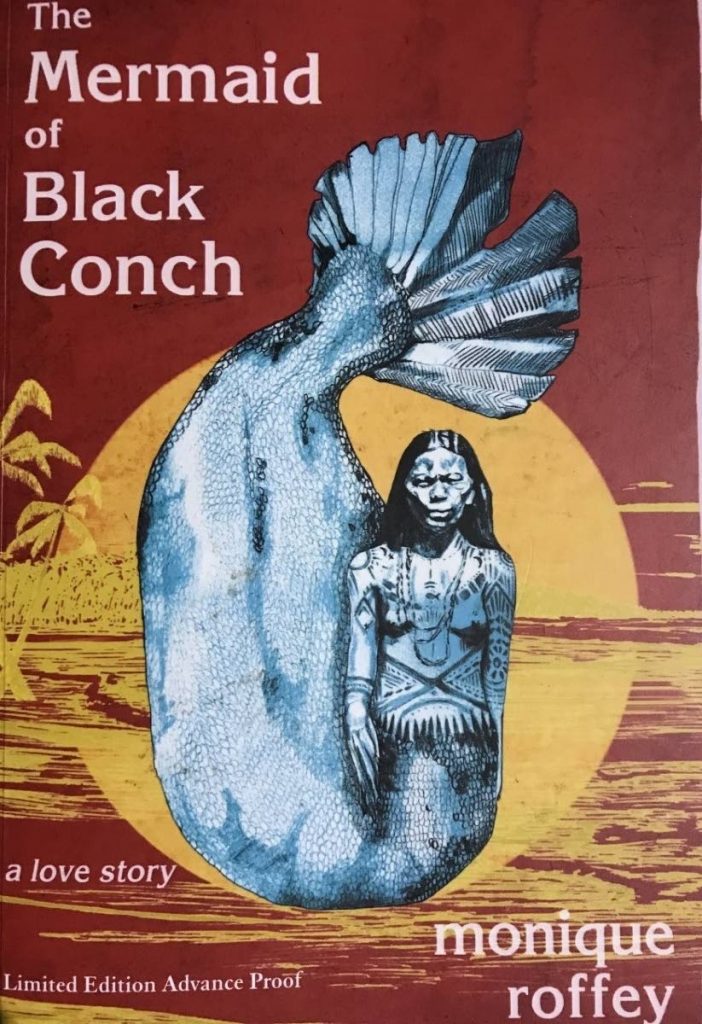Strange, touching love story

EVERY good book starts with a hook – an irresistible entry point that grabs readers’ attention. The Mermaid of Black Conch by Monique Roffey uses – you guessed it – a mermaid. But Roffey carries her mermaid tale to a whole new level.
Readers searching for a simple, entertaining read will enjoy Roffey’s strange and touching love story, which happens quite accidentally in 1976, when 26-year-old David Baptiste, a simple, ganja-smoking fisherman from Black Conch, stumbles on Aycayia, a mermaid who surfaces in response to David’s singing. Aycayia’s appearance is a fitting testimony to the power of music.
Fascinated by the mermaid’s strange and mesmerising presence, David returns the following day (without smoking ganja, he points out) to the same spot where he first saw the mermaid, but Aycayia possesses a rightful fear of humans.
Her journey from land to sea and back to land soon transcends the limitations of a love story and becomes an allegory – a story that can be read on more than one level.
When American trophy fishermen buy fishing rights for a Black Conch competition, the mermaid’s story becomes a metaphor for colonialism. Her capture and subsequent quest for freedom through David and the people who surround and love her, becomes a metaphor for slavery.

-
The true marvel of this novel is how Roffey offers so many important social and historical points for readers to consider in a light read filled with tension. Her characters and conflicts are complex, yet in many ways this is a plot-driven novel.
Roffey’s many messages never get in the way of her story, which the narrator categorises as a legend. If readers accept The Mermaid… as a legend, then they must buy into the belief that mermaids are real and some of the story is real. It is a clever narrative technique that forces readers to consider history through the vehicle of a mermaid’s story.
History, then, becomes entwined with myth and legend, and still Roffey engages in genre-bending. Can the story of a mermaid be classified as a fable and not just a legend or folk tale? Aycayia provides lessons animals teach in fables, but she is half fish and half woman. The author blurs boundaries between ocean and land, beast and human, and forces readers to consider yet another metaphor: the beauty and the agony that result when people cross cultural and ethnic or racial boundaries.
Aycayia’s Taino culture collides with David’s culture. The ancient world collides with the new world and offers fresh new ways to examine creolisation.
Then there are the two scenes with raining fish, sent by the hurricane Rosamund, personified in glory. They are unforgettable scenes with a tinge of magical realism.
The levels of exploration this novel demands often seem as deep as the ocean. Messing with the mermaid is disturbing Mother Nature and ancient mythology, and the North Americans who want to capture her and take her back to the US as a freak show represent the callousness of those bent on destruction – culturally, environmentally and otherwise.
This is a novel about alliances and beliefs people are willing to lay their lives down for – which seems like a good place to introduce the character of Life, Miss Rain’s love interest, who is part Caribbean knight, part Caribbean badjohn.
Miss Rain stumbles on the mermaid through David, and her gentle, lonely, deaf son Reggie forms a friendship with Aycayia. Reggie teaches Aycayia sign language as she navigates a new life in Black Conch. Through Reggie and Aycayia’s relationship, Roffey examines Caribbean culture’s embarrassing intolerance of the disabled.
Balance is a key to this story, and when that balance is upset, conflicts abound, providing many lessons about real-life issues that divide us. Again, without being didactic, Roffey examines the breakdown in relationships: the tension between men and women and the conflict between women and women.
“Why women hate women so?” David asks and the question cuts like a knife. Aycayia was cursed and forced to be a mermaid because she was despised for her beauty by the women of her Amerindian village. That elusive concept of beauty is an equally important theme in this novel.
Strangely enough, David loves Aycayia in spite of the fact that she is often described in unflattering ways. She smells like a fish and has pointed teeth. She vomits fish and sea plants and she stinks when she sheds her tail, but David can look beyond the surface.
On another level, the conflict between the old North American fisherman and his son is quite interesting. The old man is hell-bent on capturing and ultimately recapturing his prize “fish.” The son, scorned in many ways by the father because he does not live up to the father’s image of a man, has a change of heart. We must believe people can change.
The Mermaid of Black Conch transcends boundaries and should find itself entrenched in international literature as a story that deals with cultural identity, environmental abuse, historical injustices and individual intolerance. Powerful and provocative, this novel presents unforgettable characters in a haunting story that captures the essence of the Caribbean.
My only criticism is the book cover. The picture of Aycayia is far too wooden to capture this mermaid full of life and love and loneliness. That aside, The Mermaid of Black Conch is a novel that reminds of the price of unfairness and the rewards of trust and love. It is a Moby-Dick for our time.


Comments
"Strange, touching love story"